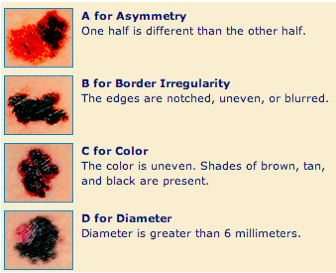
May is skin cancer month, which means we will depart from our exciting new cosmetic introductions to discuss one of the most important topics in dermatology. Over 3.5 million skin cancers are diagnosed each year, and though other cancers may get more media attention, melanoma is the most common cancer in persons aged 25-29. Not only that, but while the incidence of the seven other highest skin cancers is decreasing, melanoma continues to rise.
I am very aware that people love the sun. I myself could lie on a beach for days on end. Whether you enjoy outdoor activities or like having tan skin, ignoring the dangers of sun exposure can be extremely harmful, and even deadly. Though basal cell and squamous cell carcinomas are rarely deadly, they can cause pain, bleeding, and disfigurement. Plus, ask any patients who have had to come to me for half a day of Moh’s micrographic skin cancer surgery, and they’ll probably tell you they would have preferred to spend the time doing something else (regardless of how pleasant we try to make the process!) Luckily, I specialize in Moh’s, and if you’re in need of BCC or SCC removal, it is the best way to remove the cancer with 99.9% accuracy and maximum healthy tissue preservation.
I think most people can agree that tanning beds are officially off limits to anyone prone to skin cancer. “But Dr. Rokhsar! I want to just get a base tan at a salon so I don’t burn on vacation!” Unfortunately, the truth is that a base tan offers protection of about SPF 4, and any change in skin color comes as a result of UV exposure. Furthermore, the International Agency for Research on Cancer, an affiliate of the World Health Organization classifies tanning beds as a Class I carcinogen. What else joins tanning beds in this category? Plutonium and cigarettes…to name a few.
Now for another myth: “I don’t need to worry about skin cancer, I have darker skin.” While it is true that African-Americans, Hispanics, and Asians have fewer incidents of melanoma than Cacuasians, they also have a greater tendency to present with advanced and often times fatal disease.
So, prevention. First things first: sunblock. I always recommend a high SPF and a product that includes zinc or titanium. Most importantly, however, the sunscreen needs to be reapplied every two hours, especially when sweating or swimming. Wide brimmed hats, sunglasses, and clothing are also helpful, especially in areas (or at times such as 10-4) when sun is at its peak.
If a skin cancer does develop, early recognition is key. Melanoma analysis is easy to remember: ABCD.
Basal and squamous cell cancers can be a bit more challenging, but by paying attention to your skin regularly, you’ll easily detect changes, even subtle ones. These skin cancers often appear from a wound that doesn’t seem to heal, or a patch of skin that oozes, crusts, scales, itches, or stays red. Be sure to pay special attention to areas of frequent sun exposure, like hands, face, ears, scalp, and back.

 Dr. Rokhsar was chosen by
Dr. Rokhsar was chosen by 








